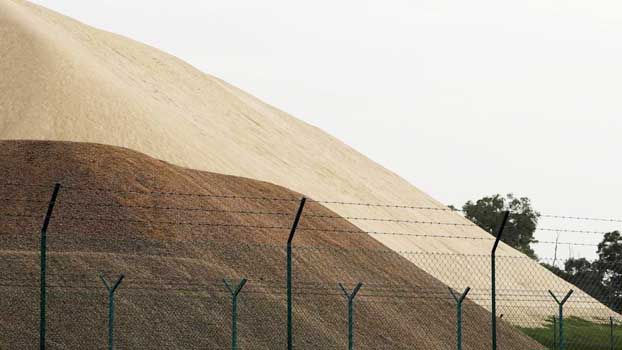What happens when Singapore runs out of sand?

Barges piled with sand traverse the sea lanes around Singapore, almost as ubiquitous as the semi trucks that ply America’s interstate highways. Aboard a small motor boat one recent afternoon, I catch sight of an imposing green wall rising from the shoreline protecting a huge sand stockpile. As one of the world’s most densely populated countries — intent on building up, down and out — Singapore couldn’t survive without millions of tons of the grainy stuff.
The city-state is slowly ticking back to life as the coronavirus lockdown eases. Yet answers to the existential questions about Singapore’s future aren’t in its glass-and-steel office towers or orchid-trimmed shopping malls or pulsing hawker centres. They’re in the water surrounding it. There, you’ll see evidence of a country half the size of Maui and among the world’s richest that’s desperate to expand.
When you’re an island nation and seas are rising, sand is something you can never find yourself without. Singapore has grown its landmass by about a quarter since the 1960s. The republic is often thought of as a single small island jammed with skyscrapers and state-of-the-art highways that can whisk you from end-to-end in about half an hour. In fact, the country is composed of anywhere between roughly 40 and 70 islands — though few residents can put a precise figure on it. Land reclamation has merged some islands over the years for industrial use, while others appear to be little more than a cluster of rocks and shrubs. A handful are reserved for the military.
Some of Singapore’s most iconic spots have sprung up in places that were once underwater: the Marina Bay Sands hotel and casino, Changi Airport and the Port of Singapore. The address of the storied Raffles Hotel isn’t One Beach Road for nothing; the shoreline, which at one point began at the end of its gravelly driveway, is now barely visible through blocks of towers and luxury condominiums.
It’s been an agonising year for the construction industry in Singapore. Activity fell 44.7% in the third quarter from a year earlier, a slightly less terrible result than the 59.9% plunge in the prior three months. While building sites are operating again, it will be a long haul. The sector has been hit particularly hard by coronavirus outbreaks in dormitories of foreign labourers, who make up a large portion of the workforce.
Yet the need for sand won’t go away, said Adam Switzer, associate chair at Nanyang Technological University’s Asian School of the Environment. “Singapore, like many other parts of the world, will need to defend its coast against future sea level rises,” Switzer said in an email. “That will almost certainly require sourcing sand.”
Climate change is truly a matter of life and death in Singapore. If global warming continues at its current pace, an area as large as 3,400 football fields in the centre of the city could be flooded by 2100, as my colleague Andy Mukherjee has noted. Leaders are acutely aware: “Everything else must bend at the knee to safeguard the existence of our island nation,” the Prime Minister Lee Hsien Loong said last year.
Singapore’s appetite for sand has become controversial. Some neighbours that used to sell it have objected, citing concerns about environmental degradation. Indonesia, Cambodia and Vietnam have ceased exports. When Malaysia banned overseas sales of sea sand in 2019, cynics suggested there was more at play: The country is trying to bulk up its own ports in and around the Straits of Johor that separate it from Singapore. Like Indonesia, Malaysia has built into the sea for real-estate developments.
Some strategies have been tested to reduce the country’s reliance on sand. In his National Day rally last year, Lee proposed poldering — a process, common in the Netherlands, that reclaims submerged land by erecting a sea wall and pumping out water. With competition for sand and other building materials intensifying across Asia, it also makes sense to think about substitutes, or whether there are geologically older inland sources that can be tapped, said Switzer. One possibility might be using pellets made from recycled glass or plastic, he added.
There may even be a solution to Singapore’s sand crunch nestled in a different problem: what to do with all its trash. Semakau Island is home to one of Singapore’s biggest rubbish-processing facilities. The site is likely to reach capacity in the middle of the next decade, but officials are working on a Plan B that would turn ash derived from incinerations as landfill to extend Semakau and help create a kind of hybrid sand, which the Straits Times reported in September could be used for concrete benches, footpaths and even a plaza.
The sea surrounding Singapore defined it long before Stamford Raffles established a British port two centuries ago. In the words of its first prime minister Lee Kuan Yew, the republic is a small place without natural resources or a hinterland, which has made the Port of Singapore critical to his vision of prosperity. As our boat ducked and weaved between containerships and tankers, spray from their swell smattering my face, it seemed there was nascent promise that commercial activity is coming back to life.
But while much of Singapore’s fortune is tied to the water, its journey from an impoverished dot to an Asian financial and commercial power has gone hand-in-hand with its need for space and sand. The country is surrounded by neighbours, at times both cooperative and jealous, that have both. Singapore’s stockpiles are as strategic as America’s petroleum reserves. Sand, or something like it, will be a hot commodity as long as there is a Singapore.
Daniel Moss is a Bloomberg Opinion columnist covering Asian economies.
Source: Bloomberg



